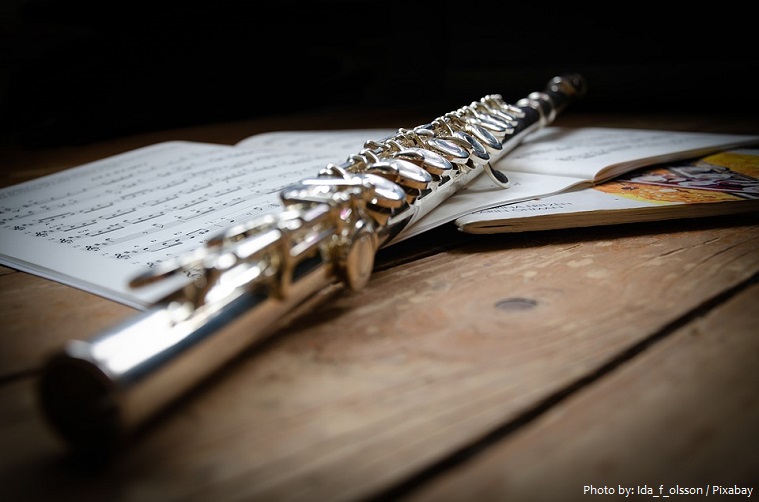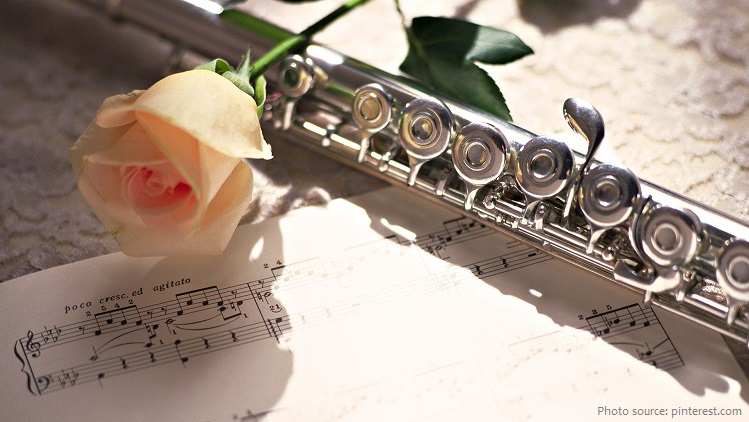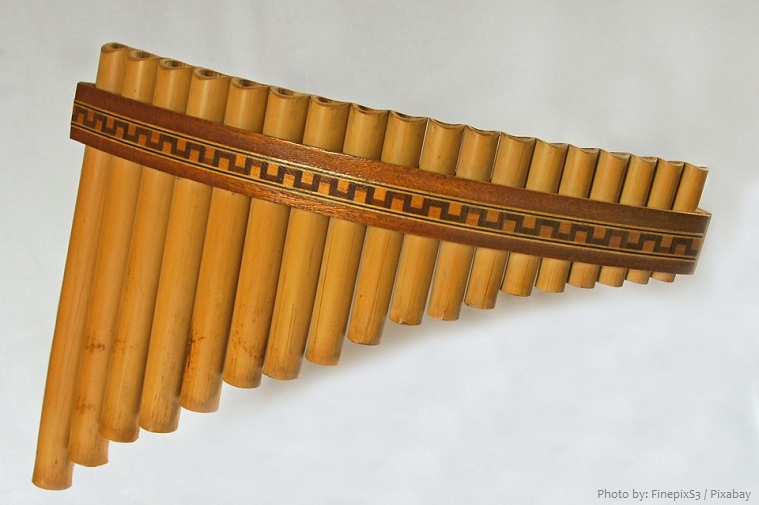The flute is a musical instrument of the woodwind family.
Unlike other woodwind instruments a flute is an aerophone or reedless wind instrument.
The sound is produced by a stream of air directed against a sharp edge, upon which the air breaks up into eddies that alternate regularly above and below the edge, setting into vibration the air
enclosed in the flute.
Most flutes are tubular, but some are globular or other shapes.
Flutes are found in virtually every world culture from the Eskimos to equatorial peoples.
The flute is one of the oldest musical instruments of all and is regarded as the first ever wind instrument.
It has been in use at least since the Stone Age.
The oldest flute ever discovered may be a fragment of the femur of a juvenile cave bear, with two to four holes, found at Divje Babe in Slovenia and dated to about 43,000 years ago.
It has been suggested that it was made by Neanderthals as a form of musical instrument, its hole spacing and alignment leading to its being labeled a “Neanderthal flute.” [photo below]
A vulture-bone flute discovered in a German cave is the world’s 2nd oldest recognizable musical instrument and pushes back humanity’s musical roots, a new study says. Found with fragments of mammoth-ivory flutes, the 40,000-year-old artifact also adds to evidence that music may have given the first European modern humans a strategic advantage over Neanderthals, researchers say. The bone-flute pieces were found in 2008 at Hohle Fels, a Stone Age cave in southern Germany, according to the study, led by archaeologist Nicholas Conard of the University of Tübingen in Germany.
The Bible, in Genesis 4:21, cites Jubal as being the “father of all those who play the ugab and the kinnor”. The former Hebrew term is believed by some to refer to some wind instrument, or wind instruments in general, the latter to a stringed instrument, or stringed instruments in general. As such, Jubal is regarded in the Judeo-Christian tradition as the inventor of the flute (a word used in some translations of this biblical passage).
Flute playing has a particularly long tradition in the Orient.
The Sumerians and Egyptians were among the first to add three or four finger-holes to their bamboo flutes, which enabled them to produce several notes.
The flute has also always been an essential part of Indian culture and mythology, and the cross flute believed by several accounts to originate in India as Indian literature from 1500 BC has made vague references to the cross flute.
The flute played an integral role in the development of Native American culture. It was used for various purposes including rituales, healing and meditation. The Native American flute is still used as an instrument in many new age music recordings today.
However, it was not until the 16th century during the Renaissance period that the prototype of the flute that plays such a prominent role in the modern orchestra first emerged and came into widespread use.
Various refinements have been added to the flute since the Renaissance period.
Theobald Boehm, the German wind instrument manufacturer, demonstrated a revolutionary new type of flute at the Paris Exhibition of 1847. This flute had a metal tube with numerous keys attached. With earlier flutes, it had been difficult to even get a note out of them, and the intervals between the notes had been variable. Boehm’s instrument was a dramatic improvement, however, and overcame these shortcomings. With his major refinements, Boehm essentially created the modern-day flute.
A modern Boehm-system flute is made of wood or metal. It is 67 cm (26.5 inches) long, with a bore of about 2 cm (0.75 in), built in three sections.
The modern professional concert flute is generally made of silver, gold, or combinations of the two. Student instruments are usually made of nickel silver, or silver-plated brass.
In addition, there are other flutes like piccolos, alto flutes, and bass flutes.
The pan flute is a form of flute with no holes. It has more than one pipe connected together, with the bottom closed. The pan flute is named after Pan, the Greek god of nature and shepherds often depicted with such an instrument. The pan flute has become widely associated with the character Peter Pan created by Sir James Matthew Barrie, whose name was inspired by the god Pan.
The largest playable flute is 3.63 m (11 ft 11 in) in length and was achieved by Bharat Sinh Parmar, Charunsudan Atri Jay Bhayani, and 5 Navtanpuri Dham (all India) as measured in Jamnagar, India, on 25 December 2014.
The longest flute marathon is 27 hr 32 min 32 sec and was achieved by Katherine Brookes (UK) in Bedworth, UK, from 3 to 4 August 2017.
The largest flute ensemble was achieved by 3,742 participants during an event organized by the Tsugaru Yokobue Guinness Executive Committee (Japan) in Hirosaki, Aomori, Japan, on 31 July 2011. The event commemorates the 400th anniversary of Hirosaki Castle.
The first known use of the word “flute” was in the 14th century. According to the Oxford English Dictionary, this was in Geoffrey Chaucer’s The Hous of Fame, c.1380.






